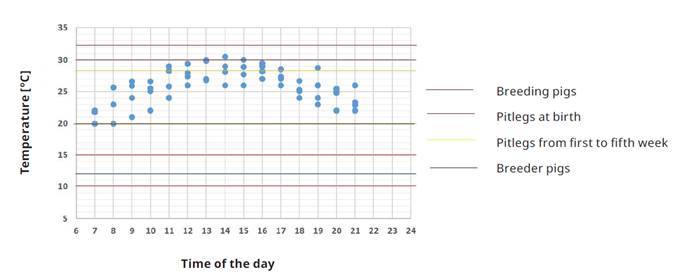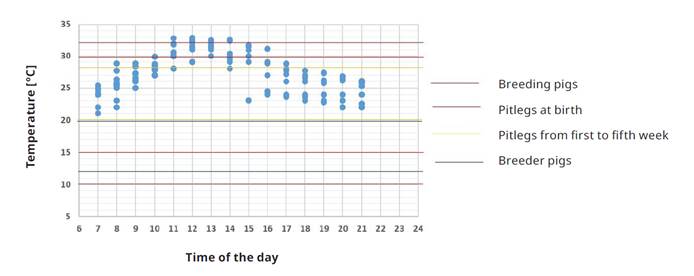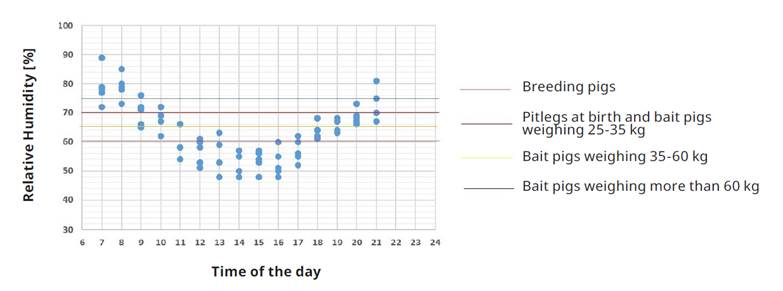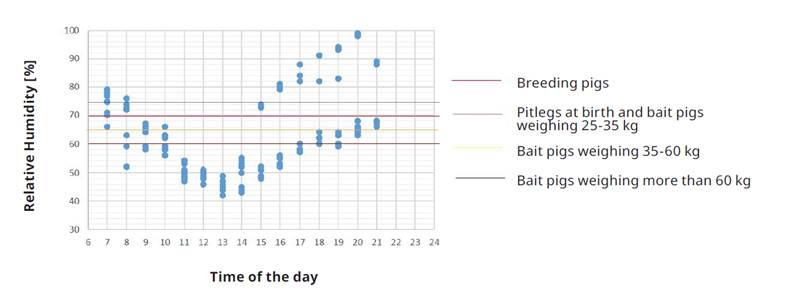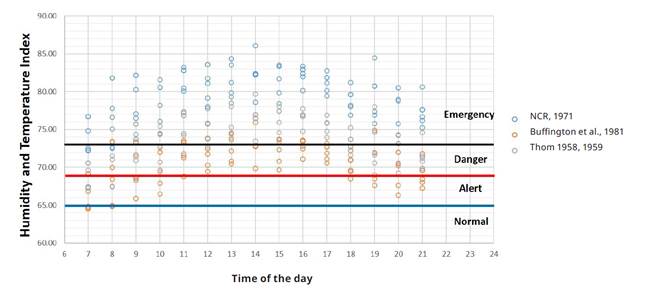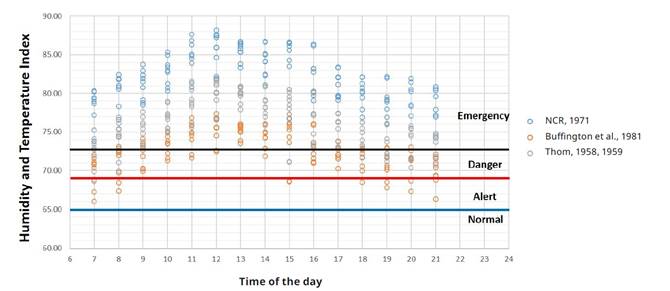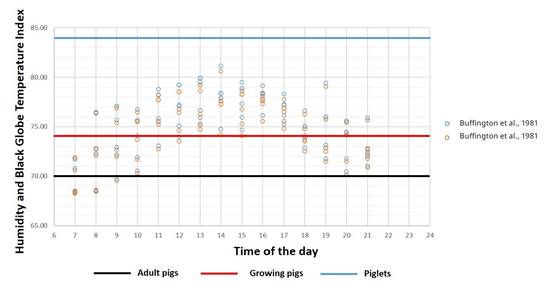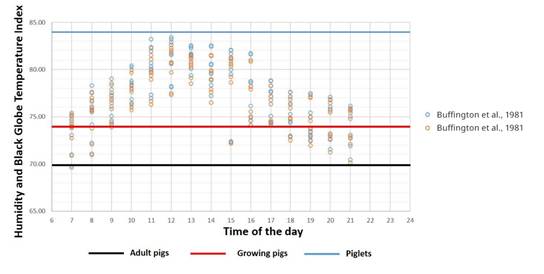Introduction
A branch of civil engineering is building construction engineering, oriented mainly to humans [1]. However, other special-use buildings for animals, called animal housing (corral or shelter or pens), are also built. Like homes, offices, and other physical spaces for humans, livestock shelters require sufficient conditions for an occupation that guarantees the performance of indoor activities pleasantly and comfortably [2]. Professions related to agricultural exploitation and production rely on civil engineering and architecture to build livestock housing and assess the indoor environmental conditions of these buildings. However, civil engineers, architects, and other construction professionals do not know how to do it.
One of the factors that influence livestock production is thermal stress, which should be considered in the evaluation of environments within livestock housing [3], [4]. On the other hand, Colombia's climate is influenced by both geographical and atmospheric aspects that modify it; this creates a vast climate and microclimate mosaic, with variations in both temperature and relative humidity (RH) in different regions of the country [5]. The thermal environment evaluation of livestock housing is increasingly essential to livestock research and production, animal welfare, and thermal comfort [6], [7].
From the knowledge of the optimal thermal comfort conditions and climatic conditions, it is possible to determine the critical environmental conditions to be considered in a livestock production project so that animal production delivers the best productivity and profitability, thus improving the decision-making for the correction of a possible malaise in the livestock species under consideration [8]. The use of various criteria for the thermal environment classification of livestock housing is increasingly widespread in the discipline since it allows considering and combining the effect of temperature, RH, air velocity, and radiation [9]-[11].
The literature reports various thermal comfort criteria that are used for thermal stress evaluation in animal production. Among them, the following stand out for their greater use in the thermal comfort and animal welfare evaluation: i.) thermal comfort range associated with RH conditions [12]; ii.) humidity and temperature index (HTI) [13]; iii.) humidity and black globe temperature index (HBGTI) [14]; iv.) radiant thermal load index [15]; v.) enthalpy calculation [16], and vi.) heat gain or loss calculation for livestock housing construction elements [12].
The livestock housing air conditioning is the creation of environmental conditions that approximate those deemed optimal for the animal species in question [17]-[19]. The most important environmental factors to consider for air conditioning are 1.) ambient temperature; 2.) the harmful gases contained in the air; 3.) air humidity, and 4.) lighting [20].
Concerning the environmental temperature for domestic animals that are homeotherms, the margin where the heat produced is enough to keep the body temperature constant is called neutral temperature. When the ambient temperature drops below the neutral temperature, the animal needs to produce more heat to keep the body temperature constant, which is called the lower critical temperature. On the contrary, when the animal puts into operation the physiological mechanisms for transferring excess heat, the ambient temperature is called the higher critical temperature [21]. Critical temperatures vary according to species, and in turn, according to race, age, feeding level, and environmental conditions. Within the neutral temperature range, the temperature at which the best processing rates for derived products are obtained is referred to as optimal [12].
For the air humidity inside livestock accommodations, it may occur in greater or lesser quantity in the form of water vapor from the animal respiration or drinking/cleaning/excrement water, among others [22]. The high RH is harmful when ambient temperatures are excessively high or low. In the case of high temperatures, the high RH hinders the evaporation process. In the case of low temperatures, the high RH moisturizes the animals' body, bed, and the livestock housing surface, increasing the cold effect when the evaporation of said moisture takes place [23]-[25].
Table 1 shows the ambient temperature and RH values for pigs that are more suitable for exploitation and production [12].
Table 1 Optimum Temperature and RH for Pigs
| Age or Stage | Temperature (°C) | RH (%) |
| Breeding pigs | 10-15 | 70 |
| Piglets at birth | 30-32 | 60 |
| Piglets in the first week | 27-28 | 60 |
| Piglets in the second week | 26-27 | 60 |
| Piglets in the third week | 24-26 | 60 |
| Piglets in the fourth week | 22-24 | 60 |
| Piglets in the fifth week | 20-22 | 60 |
| Feeder pigs weighing 20-35 kg | 18-20 | 60 |
| Feeder pigs weighing 35-60 kg | 15-18 | 65 |
| Feeder pigs weighing more than 60 kg | 12-15 | 75 |
Source: Own elaboration based on [12].
According to [26], the thermal comfort indices were developed for characterizing and quantifying the adequate comfort zone for distinct domestic animal species, and operate with correlated variables that can express the resulting environment at a particular time [27]. Thermal comfort indices may be classified as 1) biophysical indices, based on thermal exchanges between the animal body and the environment correlated to the specific animal's comfort elements; 2) physiological indices, based on the animal's physiological responses initially compared to known ideal environmental conditions; and 3) subjective indices, based on specific and subjective experimental data relating thermal sensation response and production [26], [28]. Several publications have used thermal comfort indices in distinct environmental profiles, mainly for temperature and humidity [26], [28].
HTI is one of the most widely used thermal comfort indices for evaluating the housing of animals that produce meat, milk, and eggs. In addition to the dry-bulb thermometer temperature, the index considers a measure of humidity, such as dew point temperature or RH; this allows relating the climatic conditions to the performance of animals. For its calculation, various equations (Equations 1-3) have been proposed by [13], [14], [29], [30].
HTI = (0.72 * Tdb + Twb) + 40.6 (1)
HTI = 0.80 * Tdb + (Twb - 14.3) * (RH/100) + 46.3 (2)
HTI = Tdb + 0.36 * Tdp + 41.5 (3)
Where Tbd is dry bulb temperature (°C), Twb is wet bulb temperature (°C), RH is relative humidity (%), and Tdp is dew point temperature. Tdp is calculated using Equation 4 [31]:
Tdp = ((HR/100)A(1/8)) * (112 + 0.9 * Tdb) + 0.11 * Tdb - 112 (4)
The ideal index values were established for pigs by [32], as follows: a) comfort for values between 61 and 65; b) alert for values between 65 and 69; c) danger between 69 and 73; and d) emergency for values greater than 73. The classification of the index value into a range of impact on animal welfare has also been used to evaluate the animal condition in rearing, whether in protected or unprotected environments, alerting livestock producers about unfavorable weather conditions or those that pose a risk to the animals under study [33]. Research carried out by [34] identified three factors that can be fatal for domestic animals during the summer: 1) an index greater than 84; 2) A index of the duration of the occurrence per day and for consecutive periods greater than 84, and 3) the magnitude of the previous occurrence, meaning the number of hours and intensity of the index value, as expressed by [35].
Despite not encompassing other essential variables in the thermal environment quantifications, such as solar radiation and airspeed, this first index described is widely used to involve those climatic variables that can typically and easily be arranged (temperature and RH) [33]. However, and due to the preceding, some studies have found that it does not represent the climatic conditions in regions with a high radiation index as similar values are obtained in tropical regions, considering shaded and unshaded areas [36].
HBGTI was developed by [14] and is based on the consideration of direct and diffuse solar radiation as a source of heat, which is the cause of thermal stress. It is one of the most used thermal comfort indices since it considers the effects of temperature, RH, solar radiation, and air velocity in a single value [28]. It is regarded a the most suitable index for evaluating environments in livestock housing because, in these spaces, the environment puts animals under conditions that influence not only exposure to solar radiation but also its combination with the effects of radiation, air velocity, and both dry bulb and wet bulb temperatures [37].
[14] proposed Equations 5-6 to determine HBGTI:
HBGTI = Tbg + (0.36 * Tdp) + 41.5 (5)
HBGTI = 0.72 * (Tbg + Twb) + 40.65 (6)
Where, Tbg is black globe temperature (°C) calculated according to [38], using Equation 7:
Tbg = 0.456 + 1.0335 Tdb (7)
Based on various studies of the influence of the thermal environment on the well-being of pigs at different stages [39], we compiled the most appropriate index values, as shown in Table 2.
Table 2 Reference Values for the Classification of the Thermal Environment Based on HBGTI for Each Pig Rearing Stage.
Source: Own elaboration according to [39].
The present research carried out fieldwork to monitor and characterize the thermal environment of two pigpens by recording indoor temperature and RH. The indoor temperature behavior was analyzed for the appropriate values of pig production based on the thermal comfort range associated with rh. Also, two thermal comfort indices were associated with the indoor environmental evaluation of these physical spaces.
Materials and Methods
Project location
The study was conducted in two pigpens, called Pigpen no. 1 and Pigpen no. 2, both located at the Mario González Aranda Farm (coordinates: 3°30'25.30”, 76°18'45.28W) Universidad Nacional de Colombia, Palmira campus. The farm is in the flat area of the geographical valley of the Cauca River, Southwestern Colombian, whose altitude zone is warm, with 900-1000 m.a.s.l.. The average temperature fluctuates between 23-25 °C, while the RH ranges between 65-75 %, with a maximum annual rainfall of 1,882 mm for 109 days a year [5]. According to the Koppen-Geiger climatic classification [43], the study location area has a dry tropical climate (As type) with dry summers [44].
The pigpen facilities are typical constructions for hot climates in Colombia, as described by [45], [46]. Its main construction elements are 1) structural system formed by steel columns and trusses; 2) concrete-based floors with good drainage; 3) one-meter high walls in plastered clay brick masonry, and 4) roofs with asbestos-cement and clay tile, with heights of 3.5 and 2 meters in the ridge and eaves, respectively, which allow natural ventilation. Inside, they are divided into sections to house pigs at different ages and stages. Each pigpen has an area of 195 m2, and based on the study data, houses 156 Danish Landrace pigs (88 feeder pigs and piglets, 40 sows, and 28 breeding boars).
Method
The air temperature and RH inside both pigpens were recorded following the guidelines of [47]. To this end, two measuring points were located inside each livestock housing, using a Davis 7978 standard weather station and the Traceable TM 8548 hygrometer thermometer. They recorded the measurements in the time range between 7:00- 21:00 (one-hour interval) for three non-consecutive days (at weekly intervals) in each accommodation. For both pigpens, records were taken in different months (October and November 2016).
The HTI is calculated using Equations 1-3 proposed by [13], [14], [29], [30], while the HBGTI was calculated using Equations 5-6 suggested by [14]. From the values of altitude, RH, and dry-bulb temperature, the wet-bulb temperature was calculated using the free Psicrom® simulator available on the Internet [48].
Results and Discussions
Temperature behavior inside pigpens
Fig. 1 shows the indoor temperature behavior of Pigpen no. 1. The majority of temperature measurements were above 25 °C without reaching maximums of 32 °C; variations are reached in the time range between 11:00-17:00 hours. Concerning the age of the species housed, the values show that piglets at birth have a thermal comfort range around 1 2:00-14:00 hours, from which we can infer that they would not require a heating application. Piglets of different ages have an adequate thermal comfort range between 7:00-21:00 hours, from which we concluded that the use of heating is not required. For breeding pigs and feeder pigs, the records show that they do not have a thermal comfort range within the schedule of the measurements because the temperature is higher than recommended in each case. Therefore, means are required to cool the environment and achieve lower temperatures than those presented.
For the temperature behavior inside Pigpen no. 2, Fig. 2 shows a variation in the time range between 7:00-21:00 hours and a predominant temperature variation above 25 °C during the day (8:00-20:00 hours) without reaching a maximum of 33 °C. As to the age of the species, piglets at birth have a thermal comfort range between 11:00-15:00 hours mainly, for which the application of ambient heating processes is not necessary. Concerning piglets at the first and fifth weeks of age, a thermal comfort range is not available specifically; therefore, we deduce that in this case, an air conditioning process would be needed to refresh the environment where they are located. For breeding pigs and feeder pigs, a thermal comfort range is not available, being necessary to continually refresh the environment in the places where they are located.
RH behavior inside pigpens
Fig. 3 shows the behavior of RH inside Pigpen no. 1. High RH was observed in the first and last hours of measurement, with values of 80% on average and 60-70 % at 9:00-10:00 and 18:00-19:00 hours. At intermediate hours (11:00-17:00), we noticed a significant decrease in RH with values between 50-60%. Concerning the ages of the species, for all cases, the records on the figure suggest that in the time ranges between 7:00-8:00 and 11:00-17:00 hours, the RH range is not suitable for the species and has extreme variations (high RH in the first time range, low RH in the second time range).
Fig. 4 shows the behavior of RH inside Pigpen no. 2. A trend in behavior similar to that in Pigpen no. 1 was observed. However, the measurements recorded some days at some points of the housing show a high RH variation at the beginning of the afternoon (15:00 hours). This variation could be due to additional factors inside the housing that dramatically increase the humidity in the environment, with a high saturation thereof. Those factors could be the high temperatures during the day that led to a high intake of moisture and its organic response in the animal (urination and perspiration), as well as the possible indoor washing activities and low aeration of the environment.
For the age of the species, except for points with highly saturated air, we observed a behavior very similar to that in Pigpen no. 1 for conditions of animal welfare by RH. Fig. 4 shows a time range with adequate conditions of RH at 8:00-10:00 and 18:00-21:00 hours, except for the days and points at which RH was higher than 80% (in the time range between 16:00-21:00 hours).
HTI behavior inside pigpens
Figs. 5-6 show the HTI behavior inside the pigpens. The results using the equations proposed by [13], [14], [30] are concordant, while the calculations made using the equation suggested by [29] differ, being the estimate much higher for the latter. According to [34], different equations have been proposed for the estimation of this index. However, the variation of its results and thresholds was adapted to consider areas of thermal stress (normal, alert, danger, and emergency).
Thus, for [34], the equation proposed by [29] must be analyzed with higher thresholds (less than 75, 75-79, 79-84, and greater than 84, respectively); the figures reflect similar behavior patterns, despite the differences in values, with low values in the first and last hours of the day and high values for the central hours. They also state that, for different calculation formulas, a value lower than 68 can be considered as a thermal comfort zone, and for all cases, its analysis must include both dry bulb temperature and RH. For the case study concerned, the equations proposed by [13], [14], [30] are used, analyzing the thresholds proposed by [32], as shown in Figs. 5-6.
Regarding the HTI behavior, Figs. 5-6 show that in both pigpens monitored, the index in question oscillates between values included in the alert zone (65 < HTI < 69) for the time ranges at the beginning and end of the records (7:00-9:00, 19:00-21:00), while, at the central hours, the measurements reflect conditions in danger and emergency zones (69 < HTI < 73, HTI > 73). Of note is that according to the appreciations of [34], [35], the results obtained using the equations proposed by [13], [14], [30] do not reflect risk factors for fatality since the HTI is not greater than 84.
HBGTI behavior inside pigpens
Figs. 7-8 present the behavior of the HBGTI for the interior of the pigpens monitored. They show that, despite the use of different equations, index calculations are consistent. Their values reflect the same behavior pattern in both pigpens, with low values at the beginning of the morning, and some increases up to the maximum value at noon (HBGTI ~ 80). Then, the values reduced in the afternoon, obtaining the minimum value at the beginning of the night. Regarding the pig's age/stage, the results demonstrate that most of the time, growing pigs and piglets have better welfare conditions, being more critical for adult pigs, which have poor welfare conditions (7:00-9:00 and 19:00-21:00 hours).
Discussion
Pigs show maximum performance when housed in comfortable thermal environments; the right environment is at a temperature range in which the thermal regulation processes are minimal [14], [49]-[51]. The variation in the indoor temperature values of pigpens for the time studied (Figs. 1 and 2) requires environmental control measures because it is necessary to thermally adapt the different spaces appropriately to each age of the species concerned [14], [49], [52]. In particular, there is a critical variable for piglets at birth and breeding pigs, especially in lactating sows and their newborn piglets, for which it would be necessary to adapt the space so that lactating piglets are exposed to high temperatures and adult sows to cold temperatures [14], [49], [52].
Concerning piglets at birth, they could be at risk of death in some cases and delayed development in others. For adult pigs (breeding pigs), pregnant sows could have miscarriages, and in the case of lactating sows, there could be decreases in milk secretion caused by the loss of appetite and the amount of liquid they evaporate to regulate their temperature [53], [54].
As to the variation in RH, when not within the appropriate values (Figs. 3 and 4), it affects animal welfare together with the increase in temperature [49]. In the case of the pigpens analyzed, their interiors have low values of RH within some time ranges; so, we infer that the pig at this time experiences a skin temperature lower than the ambient temperature, its perspiration evaporates and cools the body, which could be considered a favorable effect in combination with high temperatures. However, for [17], [55], the formation of dust in the housing and the dryness of the pig's airways can produce an unfavorable effect. There are also time ranges at which RH values increase, meaning that the pig experiences a temperature in its skin higher than the ambient temperature since perspiration occurs slowly, adversely affecting the maintenance of body temperature and the intake of food rations [53], [56].
The thermal environment not only encompasses air temperature and RH but other factors such as the effects of solar radiation and airspeed. In this regard, [57] states that the combination of temperature and RH is one of the main determining factors of thermal comfort and the general operation of processes, for which the determination of HTI and HBGTI allows considering these climatic factors as a whole. For the HTI values obtained, we observed that for the days analyzed, the pigs remain in conditions of thermal comfort only in the first hours of the morning and at the beginning of the night. At central hours, risk states are reached (alert and danger), including an emergency condition around noon, according to the thresholds proposed by [32]. However, the threshold of the normal zone in which thermal comfort should be experienced is HTI < 65.
The term “thermal comfort” used in this discussion is described as such because the value of HTI ~ 68 is accepted for this condition; for values in the alert zone and up to HTI = 72, the animals may experience a tolerable average discomfort [58]. The results obtained also make it possible to highlight that even though the behavior of the HTI within central hours corresponds to danger and emergency zones (HTI > 73), fatality events are not expected because the HTI does not reach a value 80 or higher, and the premises required for fatality defined by [35] are not met.
The HTI classifies the behavior of temperature and RH in general zones of thermal comfort; nonetheless, it does not allow evaluating the conditions for the ages/stages of the animals. For this purpose, this study employs another index, the HBGTI, whose behavior is shown in Figs. 7 and 8. The behavior of the index proves that piglets and pigs at younger ages have better welfare conditions in a wide range of hours of the day, while adult pigs are exposed to conditions of thermal discomfort. [34] states that smaller pigs tolerate higher climatic stress than larger pigs may be due to the higher body temperature in small animals. In the particular case of adult pigs, they are more susceptible to heat stress due to their difficulty in cooling themselves through sweat, the presence of a layer of adipose tissue, and a high percentage of lean muscle mass that contributes to increasing basal thermal production, as explained by [59].
A joint analysis of the climatic factors recorded (air temperature and RH) and climatic stress indices (HTI and HBGTI) show a consistent behavior, where the critical values of such indices occur for critical temperature conditions. RH (higher temperature and lower RH) was as expressed by [60], who describes how the isolines of thermal stress (evaluated from HTI) correspond to inverse relationships between air temperature and RH.
The monitoring of thermal stress that reflects thermal comfort suggests that these conditions compromise a variety of production parameters in the pigs housed in the pigpens studied, including growth, carcass composition, and reproduction. An extensive explanation of each parameter could be given, but it goes beyond the purpose of this paper.
A general discussion leads to establish that pig production should be carried out mainly in flat topographic areas with slightly warm climates to guarantee adequate thermal comfort, with temperatures ranging between 18 and 27 °C that are suitable for pig development [10], [61], [62]. On the other hand, climate change and global warming have affected the climatic history of tropical areas, giving rise to more prolonged droughts and high temperatures that directly and indirectly affect pig production, such as high mortality, lower feed consumption, and low weight at the end of the first years of age [63]-[66].
Conclusions
The behavior of climatic variables such as air temperature and RH within two pigpens has been studied. These pigpens are special-use buildings that are located in a hot altitude zone, with which their indoor thermal behavior will be subject to high-temperature values and creates unfavorable conditions in combination with RH values, as occurred in various time ranges. The research verified (data not shown in this document, which are available in [47]) that in the exterior of the pigpens, the temperature conditions are higher; therefore, the pigpens have a thermal resistance response due to its construction configuration, building materials, and ventilation spaces. However, the geographical location still affects the climate inside the pigpens.
The analysis of the thermal response shows that the ages corresponding to piglets at birth and breeding pigs must have spaces with air conditioning within specific time ranges. About piglets at birth, space heating will be required to maintain constant temperatures around 30 °C, while in the case of breeding pigs, the spaces must be cooled to maintain temperatures around 15 °C. Maintain dual environments for lactating sows and their newborn piglets should be taken into consideration. The physical conditions of the monitored pigpens show that they need to be modernized with controlled environment systems.
As a general conclusion, monitoring physical facilities to characterize their indoor climatic environment using criteria that combine air temperature and RH is an essential tool for planning pig production in facilities with confined conditions. This tool allows making the best decisions to obtain the maximum performance during the production process and raising the pig in a technified way, in both cold and warm climates found in the Colombian territory.













